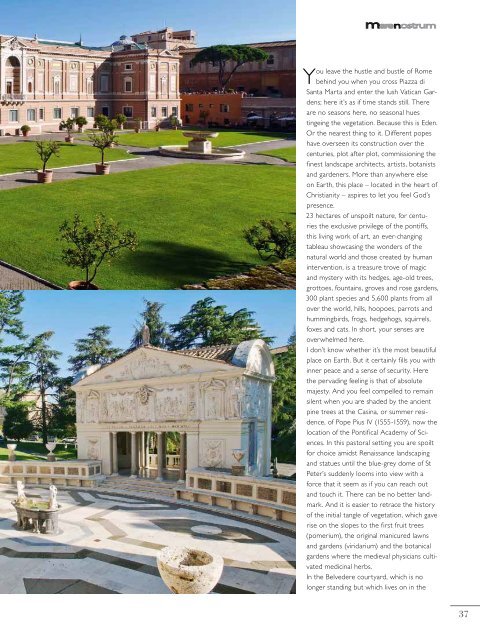umenitsa - Patrasso - Grimaldi Group
umenitsa - Patrasso - Grimaldi Group
umenitsa - Patrasso - Grimaldi Group
Create successful ePaper yourself
Turn your PDF publications into a flip-book with our unique Google optimized e-Paper software.
marenostrum<br />
Y ou leave the hustle and bustle of Rome<br />
behind you when you cross Piazza di<br />
Santa Marta and enter the lush Vatican Gardens;<br />
here it’s as if time stands still. There<br />
are no seasons here, no seasonal hues<br />
tingeing the vegetation. Because this is Eden.<br />
Or the nearest thing to it. Different popes<br />
have overseen its construction over the<br />
centuries, plot after plot, commissioning the<br />
finest landscape architects, artists, botanists<br />
and gardeners. More than anywhere else<br />
on Earth, this place – located in the heart of<br />
Christianity – aspires to let you feel God’s<br />
presence.<br />
23 hectares of unspoilt nature, for centuries<br />
the exclusive privilege of the pontiffs,<br />
this living work of art, an ever-changing<br />
tableau showcasing the wonders of the<br />
natural world and those created by human<br />
intervention, is a treasure trove of magic<br />
and mystery with its hedges, age-old trees,<br />
grottoes, fountains, groves and rose gardens,<br />
300 plant species and 5,600 plants from all<br />
over the world, hills, hoopoes, parrots and<br />
hummingbirds, frogs, hedgehogs, squirrels,<br />
foxes and cats. In short, your senses are<br />
overwhelmed here.<br />
I don’t know whether it’s the most beautiful<br />
place on Earth. But it certainly fills you with<br />
inner peace and a sense of security. Here<br />
the pervading feeling is that of absolute<br />
majesty. And you feel compelled to remain<br />
silent when you are shaded by the ancient<br />
pine trees at the Casina, or summer residence,<br />
of Pope Pius IV (1555-1559), now the<br />
location of the Pontifical Academy of Sciences.<br />
In this pastoral setting you are spoilt<br />
for choice amidst Renaissance landscaping<br />
and statues until the blue-grey dome of St<br />
Peter’s suddenly looms into view with a<br />
force that it seem as if you can reach out<br />
and touch it. There can be no better landmark.<br />
And it is easier to retrace the history<br />
of the initial tangle of vegetation, which gave<br />
rise on the slopes to the first fruit trees<br />
(pomerium), the original manicured lawns<br />
and gardens (viridarium) and the botanical<br />
gardens where the medieval physicians cultivated<br />
medicinal herbs.<br />
In the Belvedere courtyard, which is no<br />
longer standing but which lives on in the<br />
37

















